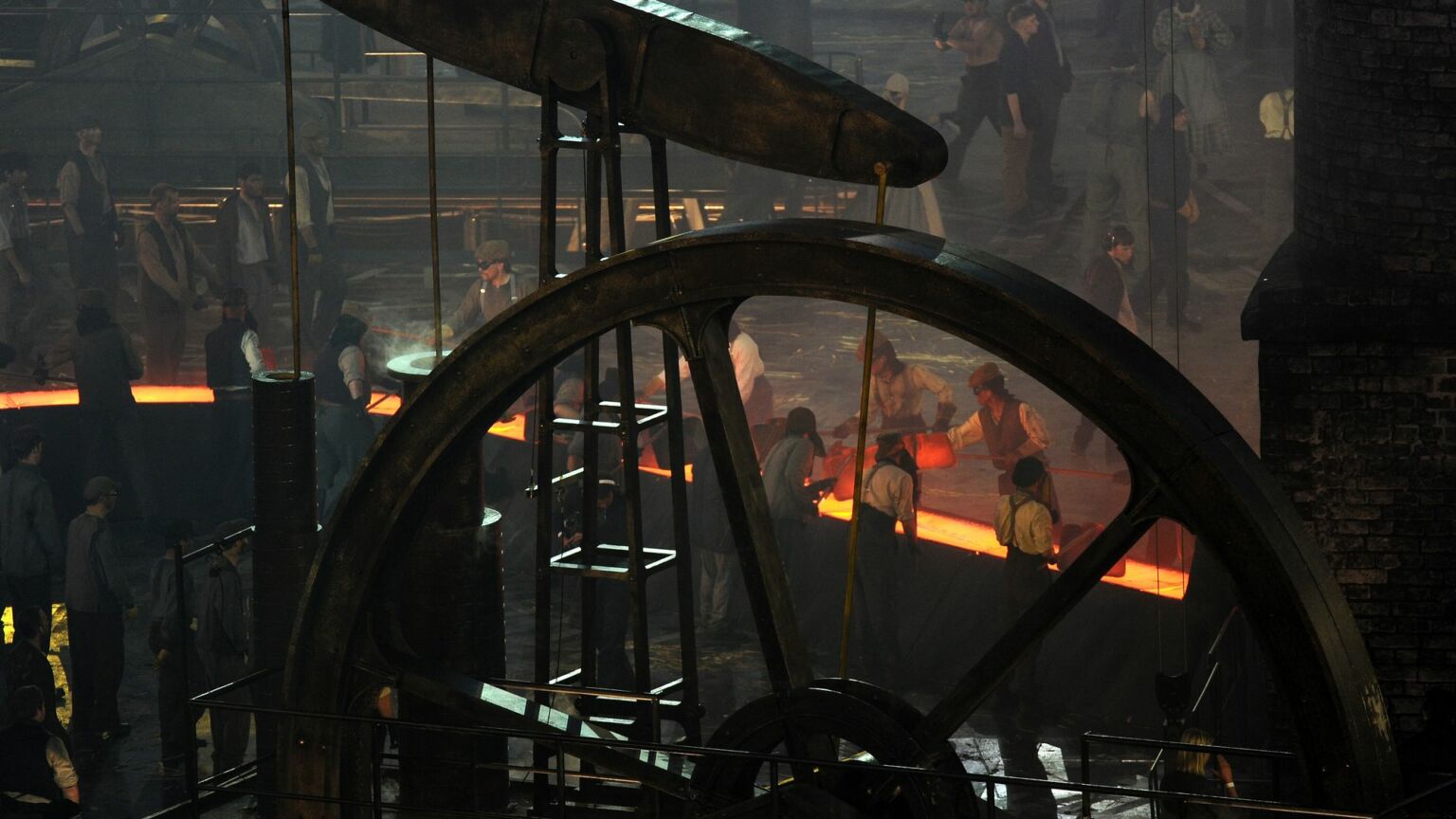No, Britain’s wealth was not built on slavery
The Industrial Revolution, not the slave trade, was the key motor of British prosperity.

In recent years, left-leaning commentators and activists have claimed that the slave trade was central to Britain’s economic development. Some have even argued that slavery is the source of much of Britain’s contemporary wealth.
Historians Maxine Berg and Pat Hudson have now added their scholarly weight to these claims in their new book, Slavery, Capitalism and the Industrial Revolution. As they put it: ‘Slavery had a long-term impact on the structure and nature of the British economy.’ Apparently, it encouraged ‘industrialisation, financialisation, elite formation and embedded inequality’.
Slavery, Capitalism and the Industrial Revolution consists, in the main, of an incisive and exhaustive working out of the many connections between the Industrial Revolution, the slave trade and the West Indian plantations.
As Berg and Hudson show, the slave trade certainly earned money for ship owners, while the British-owned plantations in the Americas made great sums from sugar, tobacco and cotton. Moreover, the incomes from the plantations were then reinvested into British industries, such as the textile industries of Lancashire and Bristol, while the plantations themselves provided a market for British manufacturers, such as for steam engines and for large kettles that could be used to boil down sugar.
Berg and Hudson rightly credit Eric Williams, the scholar and later the first prime minister of Trinidad and Tobago, with identifying the importance of slavery to the early development of capitalism. In Capitalism and Slavery, originally published in 1944, Williams argued that the profits of the slave trade were ploughed into the British economy, allowing it to take off. Williams’ ideas about the role of slavery in the early development of capitalism were inspired by the chapter on ‘primitive accumulation’ in Karl Marx’s Capital (1867). There Marx argued that the original sources of capitalist investment were seized through violence, ‘dripping from head to foot, from every pore, with blood and dirt’.
At the time, Williams’ analysis was met with a ‘blanket of scholarly silence’ by academics wanting to deny the connection between capitalism and slavery. Berg and Hudson see their own work as following in Williams’ footsteps, taking ‘a broad and multilateral view of the many connections created by slavery’.
Yet Berg and Hudson haven’t always been so keen to emphasise the centrality of slavery to the growth of British capitalism. During the 1980s and 1990s, they both wrote excellent histories of the Industrial Revolution that did not foreground slavery. These were Berg’s The Age of Manufactures (1985) and The Machinery Question and the Making of Political Economy 1815-1848 (1980), and Hudson’s The Industrial Revolution (1992).
In The Industrial Revolution, Hudson argued that ‘capital rarely flowed outside industrial regions and the bulk of finance raised by industrialists came from within a network of commercial, social and familial links’. She argued that West Indian-made wealth was more likely to be spent on conspicuous consumption, such as William Beckford’s Fonthill Abbey, a huge Gothic country house in Wiltshire that eventually had to be demolished. ‘More Fonthills than factories were built with slave profits’, wrote Hudson in 1992.
Today, both Hudson and Berg position themselves as defenders of Eric Williams’ thesis. They agree with one side of Williams’ argument – that slavery fundamentally shaped the development of British capitalism and the Industrial Revolution. But they pointedly reject the other side – namely, that slavery was one facet of a stage in the development of early, ‘mercantile’ or merchant capitalism, which was superseded by the Industrial Revolution. As Williams argued:
‘It must not be inferred that the triangular trade [Atlantic slave trade] was solely and entirely responsible for the economic development [of Britain]. The growth of the internal market in England, the ploughing-in of the profits from industry to generate still further capital and achieve still greater expansion, played a large part. But this industrial development, stimulated by mercantilism, later outgrew mercantilism and destroyed it.’
Berg and Hudson now disagree. They argue that the ‘process of merchant capitalism to industrial capitalism and on to financial capitalism’ is one single process. And they do so in order to emphasise the continuity between modern capitalism and slavery. Following historians Robin Blackburn and, more recently, Christopher L Brown, they argue that Williams’ thesis – that the development of industrial capitalism destroyed mercantilism and slavery – is simplistic and outdated.
Yet Williams’ stress on the historical transience of slavery is correct. Britain abolished the slave trade in 1807 and slavery in 1834. And it did so because slavery had become a barrier to the further economic development of capitalism. Here Williams borrowed heavily from Lowell Joseph Ragatz’s The Fall of the Planter Class in the British Caribbean (1928), which explained that the West India plantations’ profits were dwindling in the late 18th century and that they had become heavily indebted.
Berg and Hudson downplay the financial struggles of the plantations. Like many writers on slavery today, they prefer instead to emphasise the remarkable fact that slave owners were compensated for the loss of their slaves as a condition of abolition. Yet what is often overlooked is the fact that the majority of the £20million paid out went to the plantation owners’ creditors. Practically speaking, this compensation helped to free up the large sums tied up in failing Caribbean estates, so that it could be redirected to more rewarding ventures, like the new factories being built in northern England.
The abolition of slavery, then, is best seen as part of a transformation of the British economy. Capitalism in Britain went from being dominated by colonial interests to being dominated by domestic industry. As Williams put it: ‘In the age of mercantilism, Manchester was Liverpool’s hinterland, in the age of laissez faire, Liverpool was Manchester’s suburb.’
The facts speak for themselves. In 1837, the year before abolition, Britain had a workforce of 7.4million as well as 750,000 enslaved Africans in the West Indies. Twenty years later, there were no slaves, but the workforce in Britain had grown by two million. During the same period, Britain’s economic output rose from £39 billion to £62 billion.
As Williams explained, the Industrial Revolution might have owed its original seed capital to overseas colonies, but it soon had a rich source of domestically generated profits to reinvest. As Marx put it in Capital: ‘Direct force, outside economic conditions, is of course still used, but only exceptionally. In the ordinary run of things, the labourer can be left to the “natural laws of production”, ie, to his dependence on capital, a dependence springing from, and guaranteed in perpetuity by, the conditions of production themselves.’
The Industrial Revolution was not continuous with the slave trade, as Hudson and Berg have it. It represented a break with the slave trade. With the Industrial Revolution, the capitalist order in Britain turned away from colonial exploitation and towards domestic investment. Looking back on abolition, prime minister Lord Palmerston once wondered whether ‘it is a curious coincidence [that] from the time when this country first began to abolish the slave trade, followed up by abolishing slavery within the dominions of the Crown… from that period this country has prospered in a degree to which it had never experienced before’.
The way that Berg and Hudson tell it, the abolition of slavery was not as significant as we might think. Rather, they see a simple continuity between slavery and indentured labour and then the imperialism of the late 19th century. This obscures just how important anti-slavery was – not just to the reorientation of the British economy towards domestic industry, but also to Britain’s projection of power during the 19th century.
Indeed, after the Napoleonic Wars at the start of the 19th century, Britain inserted anti-slavery clauses into its treaties, obliging its allies to participate in the legal and practical policing of the slave trade. These clauses were fundamental to enforcing the Pax Britannica that gave Britain dominance of the seas. And in the late 19th century, when Britain played a leading role in the division of Africa between the colonial powers, it did so in the name of ridding Africa of its slave trade. Anti-slavery was as fundamental to Britain in the 19th century as slavery had been in the 18th century.
The development of capitalism in Britain cannot be reduced to one long history of slavery and colonial exploitation. To do so is both dishonest and tendentious. It risks turning history into little more than a stage for present-day moral posturing. The truth is far more complex.
James Heartfield is author of Britain’s Empires: A History, 1600-2020. Order it here.
Slavery, Capitalism and the Industrial Revolution, by Maxine Berg and Pat Hudson, is published by Polity. Order it here.
Picture by: Getty.
To enquire about republishing spiked’s content, a right to reply or to request a correction, please contact the managing editor, Viv Regan.









Comments
Want to join the conversation?
Only spiked supporters and patrons, who donate regularly to us, can comment on our articles.